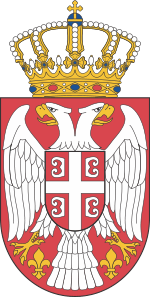Economy of Serbia
| Economy of Serbia | |
|---|---|
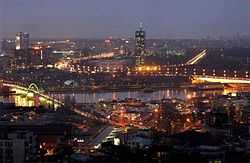 | |
| Currency | Serbian dinar (RSD) |
| Calendar year | |
Trade organisations | CEFTA, BSEC |
| Statistics | |
| GDP |
|
| GDP rank | 87th (nominal) / 81st (PPP) |
GDP growth |
|
GDP per capita |
|
GDP by sector |
agriculture: 7.9% industry: 31.8% services: 60.3% (2013 est.)[2] |
|
| |
Population below poverty line | 9.1% (2013 est.)[2] |
|
| |
Labour force |
1.703 million (2013 est.) (excluding Kosovo)[2] |
Labour force by occupation |
agriculture: 23.9% industry: 16.5% services: 59.6% (2013 est.)[2] |
| Unemployment |
|
Average gross salary |
$534 monthly (February 2015)[7] |
Average net salary |
$387 monthly (February 2015)[7] |
Main industries | motor vehicle, base metals, furniture, food processing, machinery, chemicals, sugar, tires, clothes, pharmaceuticals |
| 93rd (2014)[8] | |
| External | |
| Exports |
|
Export goods | motor vehicles ($2.054bn), electrical machines ($1.164bn), cereals ($0.786bn), fruit and vegetables ($0.748bn), and clothes ($0.629bn) (2014)[9] |
Main export partners |
|
| Imports |
|
Import goods | motor vehicles ($2.163bn), oil ($1.808bn), electrical machines ($0.813bn), natural gas ($0.807bn), medical products ($0.700bn) |
Main import partners |
|
FDI stock | $29.846 billion (From 2000-2013)[10] |
Gross external debt |
|
| Public finances | |
|
$26.73 bn (2013 est.) 61.2% of GDP (2013)[2][11] | |
|
$2.13 bn (Consolidated, 2013 est.)[2] 4.88% of GDP | |
| Revenues | $17.47 bn (Consolidated, 2013 est.)[2] |
| Expenses | $19.60 bn (Consolidated, 2013 est.)[2] |
| Economic aid | $3.49 billion of EU IPA funding (2001–2014)[12] |
Foreign reserves |
|
| Economy of Serbia |
|---|
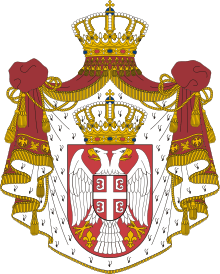 |
| Overview |
| Serbia topics |
|
Economy of Serbia is the 87th or 81st largest in the world at $42.963 billion or $93.383 billion by nominal gross domestic product or purchasing power parity respectively. Its economy is mostly based on various services (60.3% of GDP), industry (31.8% of GDP) and agriculture (7.9% of GDP).[2] In the late 1980s, at the beginning of the process of economic transition from a planned economy to a market economy, Serbia's economy had a favorable position, but it was gravely impacted by economic sanctions from 1992 to 1995.[17]
After the ousting of former Yugoslav President Slobodan Milošević in October 2000, the country went through an economic liberalization process, and experienced fast economic growth. GDP per capita (nominal) went from $1,152 in 2000 to $5,968 in 2015.[1] Furthermore, it became a candidate for the European Union in March 2012. The European Union is Serbia's most important trading partner. In 2011, the economy GDP growth was 2%.[18] Serbia entered a second recession in 2012, causing GDP to decline 1.5% for that year. In 2013, Serbia was among the top ten of European countries in regard to GDP growth, which amounted to 2.6% year on year.[19] During 2013, the unemployment rate fell from a high of 22.4% to 20.1% and incomes increased as well.[2] Estimated GDP (nominal) of Serbia for 2013 is $44.356 billion, which is $5,907 per capita. Estimated GDP (PPP) of Serbia for 2013 is $80.47 billion, which is $11,553 per capita.[2] Since the 1990s, Serbia has experienced a serious "brain drain", especially during the wars at that time. Despite the loss, the Serbian diaspora's transfers account between 10% and 15% of Serbia's GDP and significantly increase living standards in some parts of the country.[20]
In recent years, Serbia has seen an increasingly swift foreign direct investment trend, including auto industry (Fiat), metal processing (US Steel), building materials (Lafarge), food and beverages (Carlsberg, Coca Cola, and Nestle), textiles (Golden Lady, Pompea), leather (Progetti Company, Falc East), and ICT (Microsoft and Siemens).[21] By countries, most cash investments in the 2000–2012 period came from Italy ($2.69 billion), Austria ($2.65 billion), Norway ($2.16 billion), Belgium ($2.00 billion) and Greece ($1.66 billion), while other major investor countries also include United States, Russia, and Germany.[22] The actual amount of investments from countries such as the United States and Israel is significantly higher than the official figure due to their companies investing primarily through European affiliates.[23]
Overview
Macroeconomic trends
The average growth of Serbia's GDP in the last ten years was 2.45% per year. GDP structure by sector in 2013 was: services 60.3%, industry 31.8%, agriculture 7.9%.[2] GDP structure by components in 2013 was: private consumption 75.8%, public consumption 19.2%, investments 16.3%, exports 42,7%, imports -59,4%.[2]
The following table shows the GDP flow since 2000:[24]
| Year | GDP (USD bn) | GDP growth rate | GDP per capita (Nominal) | GDP per capita (PPP) | Unemployment rate |
|---|---|---|---|---|---|
| 1997 | n/a | n/a | n/a | n/a | 12.3 |
| 1998 | n/a | n/a | 2,039 | n/a | 12.8 |
| 1999 | n/a | -11.2 | 1,444 | n/a | 13.3 |
| 2000 | 8.66 | +5.3 | 1,152 | 6,233 | 12.1 |
| 2001 | 11.43 | +5.3 | 1,524 | 6,725 | 12.2 |
| 2002 | 15.16 | +4.3 | 2,021 | 7,128 | 14.5 |
| 2003 | 19.58 | +2.5 | 2,617 | 7,472 | 16.0 |
| 2004 | 23.54 | +9.3 | 3,154 | 8,413 | 19.5 |
| 2005 | 25.06 | +5.4 | 3,368 | 9,181 | 21.8 |
| 2006 | 29.33 | +3.6 | 3,957 | 9,838 | 21.6 |
| 2007 | 39.16 | +5.4 | 5,304 | 10,687 | 18.8 |
| 2008 | 47.67 | +3.8 | 6,485 | 11,361 | 14.7 |
| 2009 | 40.24 | -3.5 | 5,497 | 11,090 | 17.4 |
| 2010 | 36.38 | +1.0 | 5,030 | 11,385 | 20.0 |
| 2011 | 43.77 | +1.6 | 6,030 | 11,854 | 24.4 |
| 2012 | 38.09 | -1.5 | 5,291 | 11,982 | 23.1 |
| 2013 | 42.49 | +2.6 | 5,902 | 12,465 | 21.0 |
| 2014 | 42.65 | -0.6 | 5,924 | 12,605 | 21.6 |
Serbia's primary industries include processing of motor vehicles, base metals, furniture, food processing, machinery, chemicals, sugar, tires, clothes and pharmaceuticals.[2] The main export products of Serbia in 2013 were: motor vehicles ($2.18bn), electrical machines ($1.12bn), fruit and vegetables ($0.67bn), cereals ($0.66bn) and non-ferrous metals ($0.65bn).[9] The main Serbian agriculture products are wheat, maize, sunflower, sugar beets, fruits (raspberries, apples, sour cherries), vegetables (tomatoes, peppers, potatoes), beef, pork, and meat products, milk and dairy products, grapes/wine.[2] Agriculture accounts for 7.9% of Serbia's GDP and almost one fourth of the country's total exports, with around 23.9% of the population working in the industry.[25] The average growth of Serbian industry total from 2000 to 2013 was 1.51% per year.[26]
| Industrial production growth rate | ||||||||||||||
|---|---|---|---|---|---|---|---|---|---|---|---|---|---|---|
| Year | 2000 | 2001 | 2002 | 2003 | 2004 | 2005 | 2006 | 2007 | 2008 | 2009 | 2010 | 2011 | 2012 | 2013 |
| Mining and quarrying | 28.8 | -21.1 | 14.4 | -0.8 | -1.5 | 2.8 | 1.4 | -4.1 | 4.2 | -7.9 | 18.1 | -3.4 | -12.6 | 7.5 |
| Manufacturing | 44.7 | -13.8 | 2.0 | -7.3 | 14.2 | -10.3 | 6.1 | -1.1 | -3.5 | -16.6 | 19.7 | -4.3 | -1.4 | 6.6 |
| Electricity, gas and water supply | 8.7 | -0.9 | -2.9 | 4.0 | -2.4 | 6.7 | -4.4 | 0.6 | -1.0 | -1.2 | -4.9 | 14.2 | -16.8 | 15.2 |
| Industry total | 27.0 | -11.3 | 1.7 | -4.8 | 10.1 | -6.3 | 3.9 | -1.0 | -2.6 | -13.2 | 15 | -0.8 | -5 | 8.4 |
| Source: [27] | ||||||||||||||
Public finances
The Serbian Ministry of Finance performs tasks related to the state budget, public revenue, public spending and public debt in the country. Serbia's public debt relative to GDP from 2000 to 2008 decreased by 140.1 percentage points, and then started increasing again as the government was fighting effects of world-wide 2008 financial crisis.
| Public debt | ||||||||||||||
|---|---|---|---|---|---|---|---|---|---|---|---|---|---|---|
| Year | 2000 | 2001 | 2002 | 2003 | 2004 | 2005 | 2006 | 2007 | 2008 | 2009 | 2010 | 2011 | 2012 | 2013 |
| Debt (Billion EUR) | 14.17 | 13.43 | 11.53 | 11.02 | 9.68 | 10.28 | 9.35 | 8,88 | 8.78 | 9.85 | 12.16 | 14.78 | 17.72 | 20.14 |
| Debt (Percent of GDP) | 169.3% | 105.2% | 72.9% | 66.9% | 53.3% | 52.2% | 37.7% | 30.9% | 29.2% | 34.8% | 44.5% | 48.2% | 60.2% | 63.8% |
| Source: Ministry of Finance of Serbia | ||||||||||||||
The National Bank of Serbia is the central bank of Serbia and as such its main responsibilities are the protection of price stability, the dinar exchange rate policy, management of the foreign currency reserves and maintenance of efficient payment and financial systems. Serbian foreign exchange reserves were highly augmented from 2000 to 2007, when they amounted 10.86 billion euros. As of 2013, Serbia's budget deficit is 4.88% and the public debt is 63.8% of GDP.[28]
| Foreign exchange reserves | ||||||||||||||
|---|---|---|---|---|---|---|---|---|---|---|---|---|---|---|
| Year | 2000 | 2001 | 2002 | 2003 | 2004 | 2005 | 2006 | 2007 | 2008 | 2009 | 2010 | 2011 | 2012 | 2013 |
| National bank (Billion EUR) | 0.55 | 1.32 | 2,19 | 2.84 | 3.10 | 4.92 | 9.02 | 9.63 | 8.16 | 10.60 | 10.00 | 12.06 | 10.91 | 11.19 |
| Domestic banks (Billion EUR) | 0.39 | 0.72 | 0.68 | 0.67 | 0.59 | 0.55 | 0.52 | 1.22 | 0.92 | 1.42 | 1.68 | 0.80 | 1.06 | 0.91 |
| Total (Billion EUR) | 0.95 | 2.05 | 2.86 | 3.50 | 3.70 | 5.47 | 9.54 | 10.86 | 9.08 | 12.03 | 11.69 | 12.87 | 11.97 | 12.10 |
| Source: National Bank of Serbia | ||||||||||||||
External trade
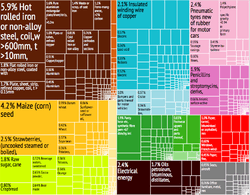
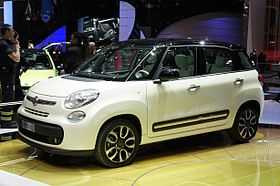
Serbia signed Free Trade Agreement (FTA) with the EU enabling exports of all products originating from Serbia without customs and other fees.[29] For a limited number of products (baby beef, sugar, and wine), annual import quotas remain in effect. As of 2013, the EU countries were the largest partners of Serbia in terms of export with the value of $8.810 billion (60.30%) and in terms of import with the value of $13.348 billion (64.99%) of Serbia.[30] The value of bilateral trade between Serbia and the EU largest economy Germany reached a total of $3.73 billion in 2013, a historical record for the two nations.[31]
Serbia signed the CEFTA enabling exports of all products originating from Serbia without customs and other fees in the region: Albania, Bosnia and Herzegovina, Macedonia, Moldova, Montenegro and UNMIK-Kosovo.[29] In 2014, the CEFTA countries were the second largest trading partners of Serbia with sufficiency of $1.895 billion.[9]
Serbia FTA with Russia was implemented since 2000, with further liberalizations in 2009 and 2011.[29] For a limited number of products, annual import quotas remain in effect. The list of products, excluded from the Free Trade Agreement with Russia, is revised annually. The CIS countries (Russia is a participating country of CIS) are also large trading partners of Serbia.[32][29]
Serbia signed a FTA with EFTA members in December 2009.[33] With Switzerland and Liechtenstein it is active as of 2010 and with Norway and Iceland as of 2011. FTA with Turkey was signed in 2009, but took effect in May 2010.[32] Trade with the U.S. is pursued under the Generalized System of Preferences (GSP). U.S. trade benefits provide for a preferential duty-free entry for app. 4,650 products.[34]
| External trade | |||||||||||||||||
|---|---|---|---|---|---|---|---|---|---|---|---|---|---|---|---|---|---|
| Year | 2002 | 2003 | 2004 | 2005 | 2006 | 2007 | 2008 | 2009 | 2010 | 2011 | 2012 | 2013 | 2014 | ||||
| Exports (mil. USD): | 2,074 | 2,756 | 3,523 | 4,480 | 6,431 | 8,823 | 10,974 | 8,345 | 9,794 | 11,780 | 11,353 | 14,614 | 14,843 | ||||
| Imports (mil. USD): | 5,614 | 7,477 | 10,755 | 10,461 | 13,174 | 19,165 | 24,332 | 15,808 | 16,471 | 19,862 | 19,014 | 20,543 | 20,650 | ||||
| Trade Balance (mil. USD): | -3,540 | -4,721 | -7,232 | -5,981 | -6,743 | -10,342 | -13,358 | -7,463 | -6,677 | -8,082 | -7,661 | -5,929 | -5,806 | ||||
| Exports/Imports (%): | 36.9 | 36.9 | 32.8 | 42.1 | 48.8 | 46.0 | 45.1 | 52.8 | 59.5 | 59.3 | 59.7 | 71.1 | 71.9 | ||||
Source: Statistical Office of Serbia
| |||||||||||||||||
Foreign direct investments
|
Leading investor nations in Serbia as of 2013: |
Serbia is open to foreign direct investment, and attracting FDI is set as a priority for the government of Serbia, which provides both financial and tax incentives to companies willing to invest.[35] Serbia has a long history of international commerce, even under communism, and it once attracted a sizeable foreign company presence, mainly due to its access to Comecon, and Non-Aligned Movement markets. Today, leading investor nations in Serbia include: Italy ($2.69bn), Austria ($2.65bn), Norway ($2.16bn), Belgium ($2.00bn) and Greece ($1.66n).[22] In a recent poll for investors, conducted by the German Chamber of Commerce, Serbia came on top as an investment destination in South-Eastern Europe, with 97% of companies being pleased with business conditions.[36] A total of $1.52 billion of foreign direct investment was received in 2013.[10]
| Foreign direct investments | ||||||||||||||
|---|---|---|---|---|---|---|---|---|---|---|---|---|---|---|
| Year | 2000 | 2001 | 2002 | 2003 | 2004 | 2005 | 2006 | 2007 | 2008 | 2009 | 2010 | 2011 | 2012 | 2013 |
| Inward FDI (USD Billions) | 0.054 | 0.177 | 0.546 | 1.511 | 1.077 | 1.579 | 5.663 | 4.389 | 3.407 | 2.729 | 1.549 | 3.018 | 2.629 | 1.518 |
| Total per capita (USD) | 7.2 | 23.6 | 72.8 | 202.0 | 144.3 | 212.2 | 764.0 | 594.6 | 461.5 | 372.8 | 212.5 | 415.8 | 365.2 | 211.9 |
| Source: [10] Inward FDI by Industries (2004–2013):
| ||||||||||||||
Blue-chip corporations making investments in Serbia include: US Steel, Philip Morris, Microsoft, Fiat, Coca-Cola, Lafarge, Siemens, Carlsberg and others.[21] In the energy sector, Russian energy giants, Lukoil and Gazprom have made large investments.[37] The banking sector has attracted investments from Banca Intesa (Italy), Crédit Agricole and Société Générale (France), HVB Bank (Germany), Erste Bank, Raiffeisen Zentralbank and Hypo Group Alpe Adria (Austria), Eurobank EFG, Piraeus Bank (Greece), and others.[38] United States based Citibank, opened a representative office in Belgrade in December 2006.[39] In the trade sector, biggest foreign investors are France's Intermarché, German Metro Cash and Carry, Greek Veropoulos, and Slovenian Mercator.
Although most investments in previous years came primarily from the EU, greater interest is being shown from countries like India and Russia. On September 25, 2007, the Government of Serbia and Indian firm Embassy Group signed a memorandum of understanding on information technology park construction.[40] Embassy Group plans to build their first technological park in Europe at an area of 280ha in the town of Indjija near Belgrade. The five-year plan predicts building a business area of 250,000 square meters and employing around 25,000 people. This is planned as the largest Greenfield investment in Serbia, accounting for a minimum of $600 million.[41] On December 24, 2008, presidents of Serbia and Russia, Boris Tadić and Dmitry Medvedev have signed oil and natural gas deal under which Gazprom's oil arm Gazprom Neft gets a 51% stake in state-owned Naftna Industrija Srbije for 400 million euros in cash and 550 million euros in investments.
There are also several architectural projects in Belgrade with foreign investment.
Domestic currency

The official currency in Serbia is the Serbian dinar - RSD (1 dinar is lowest unit), RSD = 0.0087 Euro = 0.0120 USD (12/31/2013 National Bank of Serbia exchange rate).
| USD/RSD exchange rate | ||||||||||||||
|---|---|---|---|---|---|---|---|---|---|---|---|---|---|---|
| Year | 2001 | 2002 | 2003 | 2004 | 2005 | 2006 | 2007 | 2008 | 2009 | 2010 | 2011 | 2012 | 2013 | |
| USD/RSD | 67.67 RSD | 58.98 RSD | 54.64 RSD | 57.94 RSD | 72.22 RSD | 59.98 RSD | 53.73 RSD | 62.90 RSD | 66.73 RSD | 79.28 RSD | 80.87 RSD | 86.18 RSD | 83.13 RSD | |
| Source: National Bank of Serbia | ||||||||||||||
Companies
The list includes ten largest Serbian companies by revenue in 2013 (excluding banks):[42]
| Rank | Company | Headquarters | Industry | Revenue (Mil. €) | Employees | Note | |
|---|---|---|---|---|---|---|---|
| 1. | Naftna Industrija Srbije | |
Novi Sad | Petroleum | 2,307 | 7,629 | [43] |
| 2. | Elektroprivreda Srbije | |
Belgrade | Electric utility | 1,917 | 31,569 | [44] |
| 3. | Fiat Automobili Srbija | |
Kragujevac | Automotive | 1,497 | 3,668 | [45] |
| 4. | Telekom Srbija | |
Belgrade | Telecommunications | 1,018 | 13,229 | [46] |
| 5. | Delhaize Srbija | |
Belgrade | Retail | 886 | 11,763 | [47] |
| 6. | Srbijagas | |
Novi Sad | Natural gas | 602 | 3,011 | [48] |
| 7. | Tarkett | |
Bačka Palanka | Manufacturing | 562 | 2,755 | [49] |
| 8. | Mercator-S | |
Novi Sad | Retail | 553 | 4,701 | [50] |
| 9. | IDEA | |
Belgrade | Retail | 483 | 3,954 | [51] |
| 10. | Delta Holding | |
Belgrade | Holding | 481 | 3,417 | [52] |
Transport in Serbia
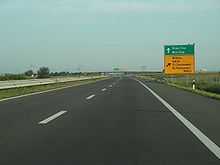

Serbia, and in particular the valley of Morava is often described as "the crossroad between the East and the West". The valley is by far the easiest way of land travel from continental Europe to Greece and Asia Minor.
Roads in Serbia are the backbone of its transportation system and constitute important transit roads in Europe. They are categorized as: state highways, class I; state highways, class II; local roads; municipal roads. Total length of public roads in Serbia is 40,845 km, of which 5,525 km are state highways, class I (including 643 km of motorways and expressways); 11,540 km are state highways, class II, and 23,780 km are local roads.
Serbian Railways, company which operates all the rail services in the country,[53] joined in 2010 to the Cargo 10, a joint venture with other railways in the region.[54] The European Bank for Reconstruction and Development has given a series of four loans to Zeleznice Srbije to support modernisation.[55]
Serbia has 3,819 kilometers of rail tracks, of which 1,279 are electrified and 283 kilometers are double-track railroad.[56]
There are two cities in Serbia (excluding Kosovo) served by international airports with regular passenger traffic: Belgrade and Niš. Belgrade Nikola Tesla Airport, a hub of flagship carrier Air Serbia, served 4,638,577 million passengers in 2014, and with the growth of 30.9% it is the fastest growing major airport in Europe.[57]
Tourism in Serbia

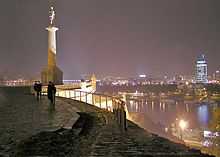
Serbia stretches across two geographic and cultural regions of Europe: Central Europe and Southeast Europe. This boundary splits Serbia roughly in a ratio of 1:2 alongside the Danube and Sava rivers. The northern parts of the country are Central-European lowlands while the southern and central parts are mostly mountainous. There are more than 15 mountain peaks rising to over 2,000 metres above sea level. The navigable rivers are the Danube, Sava and Tisa. A moderate continental climate predominates, with a more Mediterranean climate in the south.
Nightlife Belgrade has a reputation for offering a vibrant nightlife, and many clubs that are open until dawn can be found throughout the city. The most recognizable nightlife features of Belgrade are the barges (сплавови, splavovi) spread along the banks of the Sava and Danube Rivers.[58][59][60]
Tourism in Serbia employs some 75,000 people, about 4% of the country's workforce.
In 2013, total of 2,192,435 tourists visited Serbia. This was an increase of five percent compared to the last year, according to the Tourist Organization of Serbia (TOS).[61]
Energy in Serbia
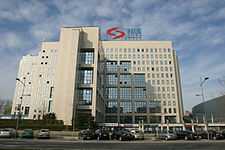
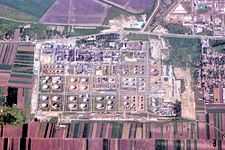
Electricity The main producer of electricity in Serbia is Elektroprivreda Srbije. The company has an installed capacity of 8,359 MW and generates 38.9 TWh of electricity per year. Its installed capacity in lignite-fired thermal power plant is 5,171 MW, gas-fired and liquid fuel-fired combined heat and power plants is 353 MW, and hydro power plants is 2,835 MW.[62] EPS is also the largest producer of lignite in Serbia operating in the Kolubara and Kostolac basins, producing around 37 million tonnes per year.[63]
Oil and Natural Gas Naftna Industrija Srbije is the only company in Serbia which deals with exploration and production of crude oil and gas, as well as with production of geothermal energy.[64] The company disposes with all necessary equipment for the performance of a whole range of complex activities such as geophysical exploration, control of production of crude oil, gas and geothermal energy. The majority of NIS oil fields are located on the territory of Serbia, in the province of Vojvodina, but upstream has business operations both in Serbia and abroad. In 2011 NIS started to expand business in south-east Europe: in Bosnia and Herzegovina, Romania and Hungary.[65][66][67]
Srbijagas, public gas company, operates the natural gas transportation system which comprise 3,177 kilometers of trunk and regional natural gas pipelines and a 450 million cubic meter underground gas storage facility at Banatski Dvor.[68] Major European transit gas pipeline, South Stream pipeline, will pass through Serbia in length of 422 kilometers and will have capacity of 40.5 billion cubic meters.[69] Start of the construction of Serbian portion of the pipeline is scheduled for the end of 2013 and will be financed with $2.6 billion by the Russian energy giant Gazprom.[70]
Renewable Energy is increasingly being used in Serbia. Installed capacity of Wind power is 20 MW (currently being expanded to produce a total of 320 MW), and hydro power plants is 2,835 MW.[71] Serbia also makes use of geothermal and solar energy, currently 39% of Serbia's electricity comes from hydro while 3.5% comes from other renewable.[2] In June 2013 the Serbian government announced an action plan to meet 27 per cent of gross final energy consumption from renewable sources by 2020.[72][73]
Telecommunications in Serbia
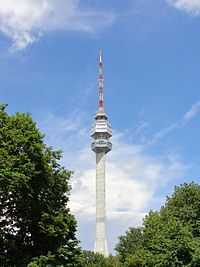
Fixed telephone lines have 89% of households in Serbia, and with about 9.8 million users the number of cellphones surpasses the number of total population of Serbia itself by 35%. The largest cellphone provider is Telekom Srbija with 5.65 million subscribers, followed by Telenor with 3.1 million users and Vip mobile with just over 1 million. 59.9% of households have computers and 55.8% have internet connection (43.4% have a broadband connection). Some 58% of households have cable TV, which is one of the highest rates in Europe. Digital television transition is set to be completed on June 17, 2015.[74]
National statistics
- Government budget (Consolidated, 2013 est.)
- Revenues: 17.47 billion USD
- Expenditures: 19.60 billion USD
Source: [2]
- Employment by sector (2013)
- Tertiary: 59.6%
- Secondary: 16.5%
- Primary: 23.9%
- Total labor force: 1.703 million
- Unemployment rate: 20.1%
Source: [2]
- External debt (2013)
- Public sector: $16.78 bn
- Private sector: $10.86 bn
- Total: $27.64bn
Source: [75]
- Energy (2013 est.)
Electricity - production: 37.65 billion kWh
Electricity - production by source:
fossil fuels:
57.5%
hydroelectric plants:
39%
nuclear fuels:
0%
other renewable sources:
3.5%
Electricity - consumption: 28.04 billion kWh
Electricity - exports: 5.71 billion kWh
Electricity - imports: 5.84 billion kWh
Crude oil - production: 24,500 barrels per day (3,900 m3/d)
Oil - exports: 0 barrels per day (0 m3/d)
Oil -imports: 33,330 barrels per day (5,299 m3/d)
Oil - proved reserves: 77.5 million barrels (12.32×106 m3) (1 January 2013)
Refined Petroleum products - production: 65,720 barrels per day (10,449 m3/d)
Refined Petroleum products - consumption: 72,700 barrels per day (11,560 m3/d)
Refined Petroleum products - exports: 16,060 barrels per day (2,553 m3/d)
Refined Petroleum products - exports: 31,120 barrels per day (4,948 m3/d)
Natural gas - production: 484.7 million cubic meters
Natural gas - consumption: 2.827 billion cubic meters
Natural gas - exports: 0 cubic metres
Natural gas - imports: 2.45 billion cubic meters
Natural gas - proved reserves: 48.14 billion cu m (1 January 2013 est.)
Source: [76]
See also
References
- ↑ 1.0 1.1 1.2 1.3 1.4 1.5 "Report for Selected Countries and Subjects: Serbia". imf.org. Retrieved 16 February 2015.
- ↑ 2.0 2.1 2.2 2.3 2.4 2.5 2.6 2.7 2.8 2.9 2.10 2.11 2.12 2.13 2.14 2.15 2.16 2.17 2.18 2.19 2.20 2.21 2.22 "Economy - overview: SERBIA". cia.gov. Retrieved 2 August 2014.
- ↑ "National Bank of Serbia expects moderate inflation growth". inserbia.info. Retrieved 2 August 2014.
- ↑ "COUNTRY COMPARISON :: DISTRIBUTION OF FAMILY INCOME - GINI INDEX". cia.gov. Retrieved 2 August 2014.
- ↑ "Serbia cuts of up to a quarter of state employee pay". balkans.com. Retrieved 2 August 2014.
- ↑ "Анкета о радној снази, IV квартал 2014.". webrzs.stat.gov.rs (in Serbian). Retrieved 16 February 2015.
- ↑ 7.0 7.1 7.2 7.3 Зараде по запосленом у Републици Србији, Feb. 2015.. stat.gov.rs (in Serbian). Републички завод за статистику. Retrieved 12 February 2015.
- ↑ "Ease of Doing Business in Serbia". doingbusiness.org. Retrieved 2 August 2014.
- ↑ 9.0 9.1 9.2 9.3 9.4 9.5 9.6 9.7 9.8 9.9 9.10 Спољнотрговинска робна размена Републике Србије, децембар 2014.. stat.gov.rs (in Serbian). епублички завод за статистику. Retrieved 16 February 2015.
- ↑ 10.0 10.1 10.2 "STRONG FDI FIGURES". siepa.gov.rs. Serbia Investment and Export Promotion Agency (SIEPA). Retrieved 3 August 2014.
- ↑ "Serbia’s external debt reached EUR 26.7 billion in February". inserbia.info. Belgrade’s Marketing Research Institute. Retrieved 2 August 2014.
- ↑ "Serbia to get EUR 178.7 million under IPA". b92.net. Retrieved 2 August 2014.
- ↑ "Sovereigns rating list". Standard & Poor's. Retrieved 4 August 2014.
- ↑ 14.0 14.1 14.2 Rogers, Simon; Sedghi, Ami (April 15, 2011). "How Fitch, Moody's and S&P rate each country's credit rating". The Guardian (London). Retrieved 4 August 2014.
- ↑ "Rating Action: Moody's assigns B1 ratings to Serbia, stable outlook". moodys.com. Retrieved 4 August 2014.
- ↑ "Fitch - Complete Sovereign Rating History". Retrieved 4 August 2014.
- ↑ Dobbs, Michael. "NATO's Latest Target: Yugoslavia's Economy". hartford-hwp.com. Washington Post. Retrieved 3 August 2014.
- ↑ Filipovic, Gordana (10 February 2012). "IMF Sees Serbian 2012 GDP Up 0.5%, Jobless Rate ‘a Concern'". Bloomberg.
- ↑ "GDP growth (annual %)". woldbank.org. Retrieved 2 August 2014.
- ↑ K., E. "DIJASPORA POMAŽE SRBIJU: Od doznaka 5,5 milijardi dolara". kurir-info.rs (in Serbian). Retrieved 2 August 2014.
- ↑ 21.0 21.1 "Success Stories". siepa.gov.rs. Retrieved 2 August 2014.
- ↑ 22.0 22.1 "12-year FDI inflow worth EUR 16bn; Italy tops list". b92.net. Tanjug. Retrieved 2 August 2014.
- ↑ "INVESTING IN SERBIA 2013" (PDF). siepa.gov.rs. Serbia Investment and Export Promotion Agency. Retrieved 2 August 2014.
- ↑ "Report for Selected Countries and Subjects: Serbia". imf.org. Retrieved 5 April 2015.
- ↑ "Agriculture represents almost one fourth of Serbia's total exports". balkans.com. Retrieved 2 August 2014.
- ↑ "Industrial production indices by sectors". stat.gov.rs. Retrieved 2 August 2014.
- ↑ "Електронска библиотека: претрага". stat.gov.rs. Retrieved 3 August 2014.
- ↑ "Macroeconomic Data" (PDF). javnidug.gov.rs (in Serbian). Retrieved 2 May 2014.
- ↑ 29.0 29.1 29.2 29.3 "LIBERALIZED TRADE". siepa.gov.rs. Retrieved 3 August 2014.
- ↑ "Top Trading Partners - Trade Statistics" (PDF). europa.eu. European Commission. Retrieved 3 August 2014.
- ↑ "Robna razmena između Srbije i Nemačke dostigla rekord u 2013.". plutonlogistics.com (in Serbian). Republički zavod za statistiku. Retrieved 3 August 2014.
- ↑ 32.0 32.1 "SERBIA" (PDF). mtt.gov.rs. Ministry of Foreign and Internal Trade and Telecommunications. Retrieved 3 August 2014.
- ↑ "Potpisan sporazum sa zemljama EFTA". b92.net (in Serbian). Fonet. Retrieved 3 August 2014.
- ↑ "America Open for Trade, Serbia for Investments" (PDF). promoney.rs. Ministry of Economy of Serbia. Retrieved 3 August 2014.
- ↑ "Investment Incentives". siepa.gov.rs. Retrieved 3 August 2014.
- ↑ "Serbia ranked first in investors' poll". emportal.co.rs. Retrieved 3 August 2014.
- ↑ "Why Invest: Serbia". doingbusinessinserbia.com. Retrieved 3 August 2014.
- ↑ "List of Banks". nbs.rs. Retrieved 3 August 2014.
- ↑ "Citibank to open office in Serbia".
- ↑ "Serbia to get first IT park". aljazeera.com. Retrieved 3 August 2014.
- ↑ "Embassy Group Will Build $390 Million-Euro IT Park in Serbia". bloomberg.com. Retrieved 3 August 2014.
- ↑ СТО НАЈ... ПРИВРЕДНИХ ДРУШТАВА У РЕПУБЛИЦИ СРБИЈИ У 2013. ГОДИНИ (PDF). apr.gov.rs (in Serbian). Агенција за привредне регистре. Retrieved 31 July 2014.
- ↑ "Подаци о обвезнику: Naftna Industrija Srbije". apr.gov.rs (in Serbian). Агенција за привредне регистре. Retrieved 31 July 2014.
- ↑ "Подаци о обвезнику: Elektroprivreda Srbije". apr.gov.rs (in Serbian). Агенција за привредне регистре. Retrieved 31 July 2014.
- ↑ "Подаци о обвезнику: Fiat Automobili Srbija". apr.gov.rs (in Serbian). Агенција за привредне регистре. Retrieved 31 July 2014.
- ↑ "Подаци о обвезнику: Telekom Srbija". apr.gov.rs (in Serbian). Агенција за привредне регистре. Retrieved 31 July 2014.
- ↑ "Подаци о обвезнику: Delhaize Serbia". apr.gov.rs (in Serbian). Агенција за привредне регистре. Retrieved 31 July 2014.
- ↑ "Подаци о обвезнику: Srbijagas". apr.gov.rs (in Serbian). Агенција за привредне регистре. Retrieved 31 July 2014.
- ↑ "Подаци о обвезнику: Tarkett". apr.gov.rs (in Serbian). Агенција за привредне регистре. Retrieved 31 July 2014.
- ↑ "Подаци о обвезнику: Mercator-S". apr.gov.rs (in Serbian). Агенција за привредне регистре. Retrieved 31 July 2014.
- ↑ "Подаци о обвезнику: IDEA". apr.gov.rs (in Serbian). Агенција за привредне регистре. Retrieved 31 July 2014.
- ↑ "Подаци о обвезнику: Delta Holding". apr.gov.rs (in Serbian). Агенција за привредне регистре. Retrieved 31 July 2014.
- ↑ "General Information". Serbian Railways.
- ↑ "Balkan railways: From Berlin to Beijing?". The Economist. 2010-09-26. Retrieved 2010-09-26.
- ↑ "New EBRD funds to improve rail infrastructure in Serbia". Retrieved 2010-10-07.
- ↑ СТАТИСТИЧКИ ГОДИШЊАК РЕПУБЛИКЕ СРБИЈЕ (PDF). stat.gov.rs (in Serbian). Republički zavod za statistiku. Retrieved 3 August 2014.
- ↑ "2013 Traffic Figures". beg.aero. Aerodrom Nikola Tesla. Retrieved 17 March 2015.
- ↑ Eve-Ann Prentice (2003-08-10). "Why I love battereBelgrade". The Guardian Travel (London). Retrieved 2007-05-19.
- ↑ Seth Sherwood (2005-10-16). "Belgrade Rocks". The New York Times. Retrieved 2007-05-19.
- ↑ Barbara Gruber (2006-08-22). "Belgrade's Nightlife Floats on the Danube". Deutsche Welle. Retrieved 2007-05-19.
- ↑ "Туристички промет у Републици Србији у 2013. години". srbija.travel. Републички завод за статистику. Retrieved 3 August 2014.
- ↑ "About Us". eps.rs. Retrieved 3 August 2014.
- ↑ "EPS". Energy Fundamentals. Retrieved 15 June 2013.
- ↑ "Cooperation of Vojvodina and NIS in the field of geothermal energy". vibilia.rs. Retrieved 3 August 2014.
- ↑ "Serbia's NIS to expand in four E. European states". Reuters. 2 September 2011.
- ↑ "NIS plans to invest into Romania several hundred million euros". vibilia.rs. Retrieved 3 August 2014.
- ↑ "NIS and RAGF signed an Agreement on Exploration in Hungary". vibilia.rs. Retrieved 3 August 2014.
- ↑ "Transport prirodnog gasa". srbijagas.com (in Serbian). Retrieved 3 August 2014.
- ↑ "Gazprom mulls funding Srbijagas's share of South Stream pipeline construction costs". seenews.com. Retrieved 3 August 2014.
- ↑ "Russia to invest 1.7 million euro to the South Stream gas pipeline with Serbia Read more: http://voiceofrussia.com/2013_04_10/Russia-to-invest-1-7-million-euro-to-the-South-Stream-gas-pipeline-with-Serbia-241/". voiceofrussia.com. Retrieved 3 August 2014.
- ↑ "Electric Power Industry of Serbia" (PDF). reneuer.com. Retrieved 3 August 2014.
- ↑ "Energy: Serbia’s renewables growth aims to outstrip EU". ft.com. Financial Times. Retrieved 3 August 2014.
- ↑ "Serbia’s 2020 Energy-Mix Target to Set Renewables at 27 Percent". bloomberg.com. Retrieved 3 August 2014.
- ↑ "Ljajić: Srbija ogromno kasni sa uvođenjem digitalizacije". blic.rs (in Serbian). Retrieved 3 August 2014.
- ↑ "ANALYSIS OF THE REPUBLIC OF SERBIA’S DEBT" (PDF). nbs.rs. National Bank of Serbia. p. 8. Retrieved 3 August 2014.
- ↑ "Energy ::SERBIA". cia.gov. Central Intelligence Agency. Retrieved 3 August 2014.
External links
| Wikimedia Commons has media related to Economy of Serbia. |
- Serbia Investment and Export Promotion Agency
- Serbian Chamber of Commerce
- National Bank of Serbia
- Belgrade Stock Exchange
| ||||||||||||||||||

